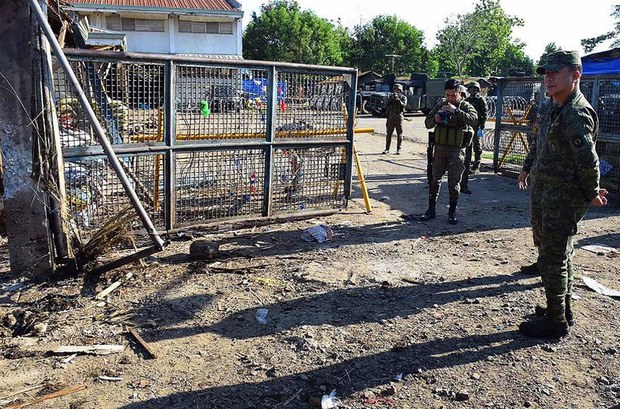Philippine Defense Chief: Latest Suicide Bombing in South ‘Very Important’ Development
2019.07.01
Cotabato, Philippines
 Maj. Gen. Cirilito Sobejana (right), chief of the Philippine Army’s Western Mindanao Command, inspects the scene outside the headquarters of the 1st Battalion Combat Team in Indanan town after two suicide bombers detonated their explosives, June 29, 2019.
Maj. Gen. Cirilito Sobejana (right), chief of the Philippine Army’s Western Mindanao Command, inspects the scene outside the headquarters of the 1st Battalion Combat Team in Indanan town after two suicide bombers detonated their explosives, June 29, 2019.
The Philippine defense chief expressed concern Monday over an increase in deadly militant-linked attacks, saying that a twin suicide bombing that killed eight people outside a military camp in the southern Philippines signified a “very important development.”
Two militants linked to a group led by Hatib Hajan Sawadjaan killed themselves by detonating their explosives outside the camp of the Army’s 1st Infantry Brigade Team in Indanan town in Sulu province on Friday, leaving three soldiers dead. The explosions killed three civilians and wounded 22 other people, including 12 soldiers, authorities said.
“It is evident from the report because this guy knocked on the gate, so the guard went near to ask what the person [needed]. So when the guard was at the gate, the person exploded, so this is obviously a suicide bombing,” Defense Secretary Delfin Lorenzana told reporters in Manila.
“I think it’s a suicide bombing because he was carrying the bomb and he detonated it within the perimeter. There were two of them actually,” he said.
The attacks Friday were carried out by Filipino nationals, marking the first time that locals were used as suicide bombers, said national police chief Gen. Oscar Albayalde, citing police intelligence sources. He did not divulge details, pending an investigation.
The attack was the third suicide bombing recorded in the Philippines since last year. In August 2018, a German of Moroccan descent drove a van filled with explosives through a checkpoint in southern Basilan island, leaving 11 dead. In January, two suicide bombers detonated bombs at a Catholic Church on Jolo island, killing 23 people.
Lorenzana said Friday’s suicide bombing represented “a very important development” in the south, where militants linked with Islamic State (IS) were trying to regroup after being defeated in a five-month battle in southern Marawi city two years earlier.
“This is the third one. The first one was in Lamitan (Basilan), the second was in a cathedral in Jolo. It’s becoming an occurrence and we are very much concerned about this,” Lorenzana said.
Radulan Sahiron, a senior leader of the Abu Sayyaf militant group, worked with Sawadjaan in carrying out Friday’s attack in Jolo, said Maj. Gen. Cirilito Sobejana, the military’s newly installed chief of the Western Mindanao Command.
Sahiron was a key member of Abu Sayyaf, which Philippine authorities have blamed for a rash of kidnapping attacks and bombings in the 1990s. Little has been heard about him during the past decade, but he is known to command loyal fighters.
Sawadjaan is a religious elder who, according to the U.S. Defense Department, is believed to have taken over the reins of the IS branch in the Philippines from Isnilon Hapilon, who was killed in Marawi.
“Both of them were coddling foreign terrorists. It was public knowledge that Sawadjaan has pledged allegiance to the Islamic State for Iraq and Syria terror group,” Sobejana said, using another name for IS.
IPAC: ‘Question of indoctrination’
The latest attacks show that a commitment to IS “remains strong within some factions of the Abu Sayyaf Group,” said Sidney Jones, director of the Jakarta-based Institute for Policy Analysis of Conflict.
“[T]here is nothing about Filipino culture that makes young people ‘immune’ from suicide bombing. It's a question of indoctrination,” Jones told BenarNews.
Sawadjaan was elected by leaders of the IS East Asia Wilayah as “successor” to Hapilon, and the power dynamics within the small, volatile group have yet to be clearly defined, she said.
“The ISIS central did not choose him but we understand he was elected as a successor,” to Hapilon, Jones said, referring to IS by a different acronym.
While government troops have been on heightened alert in the south during the past two years, local and foreign militants allied with IS have not totally disappeared. In the meantime, the government has been exerting itself to try and prevent more carnage, but to no avail, security experts said.
“I take the word of ISIS for claiming the incident as a suicide attack, because they claimed responsibility for the Marawi City siege, which turned out to be true,” said Rommel Banlaoi of the Philippine Institute for Peace, Violence and Terrorism Research.
The Philippines, particularly the southern region of Mindanao, has become “an alternative base for Jihad,” he said.
“In fact, just a few weeks ago a group claiming to be followers of Islamic State has pledged allegiance to ISIS again, and the [propaganda] film was done in the Philippines. Particularly from the Middle East, and most particularly in Malaysia and Indonesia, people are being encouraged to come to the Philippines in order to mount violent incidents in southern Philippines,” Banlaoi said.







